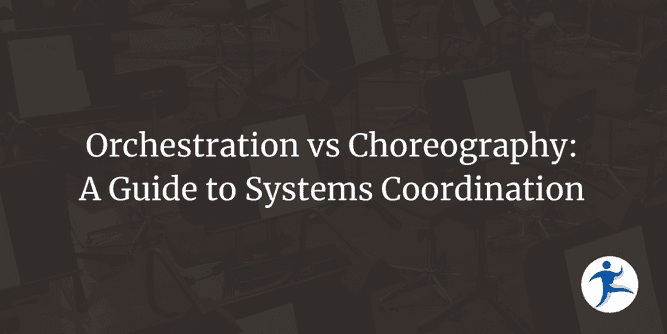Imagine you’re at a concert. You have the conductor, who is the orchestrator, making sure each instrument plays its part at the right time. Then you have a dance troupe, where each dancer knows their moves and responds to the music and each other - that’s choreography. In the world of IT, particularly with microservices, we use these concepts to manage how different components interact. Let’s dive into the details.
Orchestration: The Conductor’s Baton
Orchestration is like having a conductor for your IT systems. A central component, the orchestrator, directs the interactions between services. It tells each service what to do and when, ensuring everything works together smoothly. This approach relies on centralized control and command-driven communication, making it well-suited for complex, sequential workflows where order is critical.
The main benefits of orchestration include clear visibility and direct control over the entire process, which simplifies managing complex workflows and troubleshooting issues when they arise. However, it can also lead to tight coupling between services, creating a single point of failure risk. The orchestrator itself can also become a bottleneck if it has to manage too many interactions.
Example of Orchestration: eCommerce Order Fulfillment
Consider an online store where a customer places an order. A central Order Processor service acts as the orchestrator:
- The Order Processor receives a new order.
- It calls the Inventory Service to check stock and reserve items.
- Upon successful reservation, it then calls the Payment Gateway Service to process the payment.
- If payment is successful, it calls the Shipping Service to arrange delivery.
- Finally, it calls the Notification Service to send the customer an order confirmation.
In this scenario, the Order Processor dictates every step, knowing the exact sequence and waiting for each step to complete before proceeding to the next. If the payment fails, the orchestrator might instruct the Inventory Service to release the reserved items.
Choreography: The Dance of Services
Choreography, on the other hand, is like a dance troupe. Each service knows its role and interacts with others through events. There’s no central controller; services simply publish events when something happens and react autonomously to events they are interested in. This is a decentralized control method, driven by event-driven communication, making it ideal for flexible, loosely coupled systems.
The primary benefits of choreography are its high scalability and resilience, as services can be developed and maintained independently without affecting the whole. This also improves fault tolerance. However, a lack of central oversight means it can be difficult to get a holistic view of the entire system’s flow, and troubleshooting can be more complex since interactions are distributed. Managing complex interactions without a central coordinator can also present challenges.
Example of Choreography: Product Catalog Update
Imagine a large eCommerce platform where product information is updated. Instead of a central service managing the updates for every downstream system, services react to events:
- A Product Service updates a product’s price or description.
- It then publishes a
ProductUpdatedevent to a message broker (e.g., Kafka, RabbitMQ). - The Search Indexing Service, which subscribes to
ProductUpdatedevents, picks up the event and updates its search index accordingly. - The Recommendation Engine Service, also subscribed to
ProductUpdatedevents, receives the event and re-evaluates product recommendations for customers. - The Marketing Email Service, subscribing to relevant events, might trigger an email campaign for newly discounted products.
Here, no single service tells the Search Indexing Service or Recommendation Engine to update. They independently react to the ProductUpdated event, performing their specific tasks without explicit coordination from a central entity.
Which Approach to Choose?
There’s no single “best” approach. The right choice depends on your specific needs and the nature of your system. Opt for orchestration when you need tight control over workflows, a guaranteed execution order, and clear visibility into the entire process. This is often preferred for business processes with strong transactional requirements.
Choose choreography for systems that prioritize flexibility, scalability, and independence among services. This is a common pattern in modern microservices architectures where services need to evolve quickly and independently. For many complex systems, a hybrid approach often works best, combining the strengths of both – perhaps using orchestration for high-level business processes while allowing individual services to communicate via choreography.
Example of a Hybrid Scenario: New Employee Onboarding
Consider the process of onboarding a new employee in a large organization. This involves a mix of sequential, critical steps and parallel, reactive updates. A central Employee Onboarding Orchestrator service is activated when an offer is accepted. It first calls the HR System Service to create the new employee record. Upon successful creation, it triggers the IT Provisioning Service to set up accounts (email, internal systems), and order hardware. Simultaneously, it might instruct the Payroll Service to add the employee for salary processing. Finally, after all core setup is confirmed, it triggers the “Welcome & Start Date” notification.
When the HR System Service successfully creates the employee record, it publishes an EmployeeCreated event. The Internal Communications Service, subscribed to this event, might automatically add the employee to relevant mailing lists and team channels. The Facilities Service, also subscribed, receives the event and initiates workstation setup and badge creation. The Training & Development Service subscribes to the event and automatically assigns initial mandatory training modules. After the IT Provisioning Service completes setting up accounts, it publishes an ITSetupComplete event. The Manager Notification Service subscribes to this, informing the employee’s manager that IT resources are ready. The Asset Management Service updates its records for new hardware issued.
In this hybrid model, the orchestrator ensures the critical path (employee record, IT setup, payroll) is followed precisely, managing dependencies and potential rollbacks. Concurrently, various other services react to key events, handling parallel tasks like communication, physical setup, and ongoing learning, without direct instruction from the orchestrator.
Conclusion: Finding Harmony in Complexity
Just like a symphony or a dance, the key to successful systems is coordination. Whether you choose the conductor’s approach or the dancers’ way, understanding the nuances of orchestration and choreography will help you build robust, scalable, and maintainable systems.




